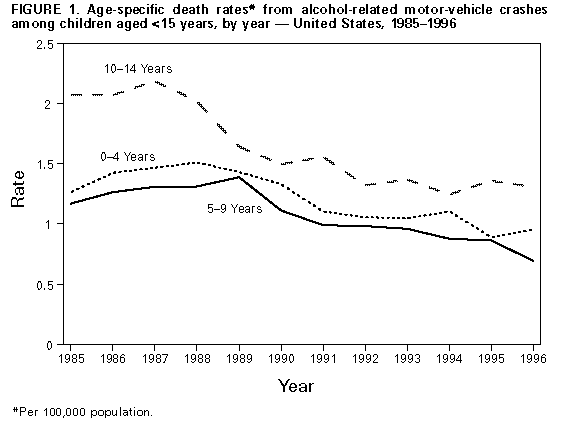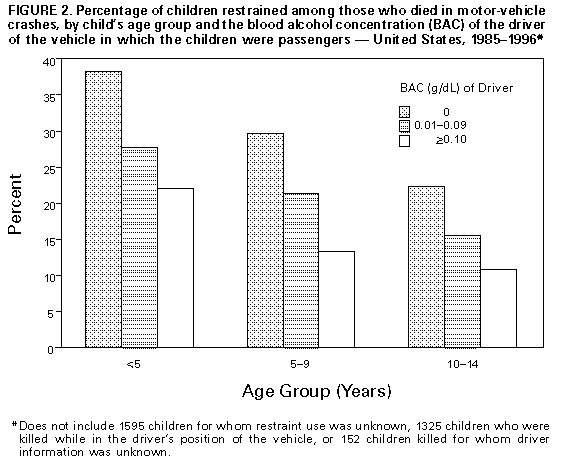 |
|
|
|
|
|
|
| ||||||||||
|
|
|
|
|
|
|
||||
| ||||||||||
|
|
|
|
|
Persons using assistive technology might not be able to fully access information in this file. For assistance, please send e-mail to: mmwrq@cdc.gov. Type 508 Accommodation and the title of the report in the subject line of e-mail. Alcohol-Related Traffic Fatalities Involving Children -- United States, 1985-1996Motor-vehicle-related injuries are the leading cause of death for persons aged 1-24 years in the United States (1). Although the relation between alcohol use and motor-vehicle-related deaths involving teenagers is well established (2), understanding of the role of alcohol in such deaths among younger children is limited. To characterize the involvement of alcohol in motor-vehicle-related deaths of U.S. children aged less than 15 years during 1985-1996, CDC analyzed data from the Fatality Analysis Reporting System (FARS) of the National Highway Traffic Safety Administration (NHTSA). This report summarizes the results of that analysis, which indicate that approximately one fourth of all traffic deaths among children aged less than 15 years involved alcohol and that in nearly two thirds of passenger deaths involving a legally drunk driver, the child was in the car driven by the legally drunk driver. FARS is a census of police-reported traffic crashes on public roadways that result in the death of at least one occupant or nonmotorist within 30 days of the crash. NHTSA considers a fatal motor-vehicle crash to be alcohol related if either a driver or non-occupant (e.g., pedestrian) had a blood alcohol concentration (BAC) greater than or equal to 0.01 g/dL. Because BACs are not available for all persons involved in fatal crashes, NHTSA estimates the number of alcohol-related traffic fatalities based on a discriminant analysis of information from all cases for which driver or nonoccupant BAC data are available (3). Age adjustment of rates was performed by the direct method using the 1970 U.S. population. During 1985-1996, of the 35,547 children aged less than 15 years who died in motor-vehicle crashes, 8482 (24%) were killed in alcohol-related motor-vehicle crashes. From 1985 to 1996, the proportion of all motor-vehicle-related deaths that involved alcohol decreased from 25% (773 of 3126 deaths) to 21% (568 of 2761). The death rate per 100,000 population attributable to alcohol-related crashes declined among children aged 0-4, 5-9, and 10-14 years (Figure_1). Among all children aged less than 15 years, the average annual death rate from alcohol-involved crashes was 1.3 times greater for males than for females (1.47 compared with 1.11). During 1985-1996, a total of 5771 children died while traveling as occupants in a motor vehicle involved in an alcohol-related crash, composing 68% of all alcohol-related traffic fatalities among persons aged less than 15 years; an additional 1854 (22%) children who died were pedestrians, and 719 (8%) were bicyclists (for 137 {2%} fatalities, the status was unknown). From 1985 to 1996, the age-adjusted death rate for children who were motor-vehicle occupants in alcohol-involved crashes declined 26% (from 0.95 to 0.70); for those who were pedestrians, the rate declined 51% (from 0.39 to 0.19). For bicyclists aged 5-14 years, the rate of involvement in alcohol-related motor-vehicle crashes declined 62% (from 0.24 to 0.09). From 1985 through 1996, a total of 3830 children aged less than 15 years were killed as passengers in a motor-vehicle crash involving a driver whose BAC was greater than or equal to 0.10 g/dL. Of these, 2280 (60%) died while riding in the same vehicle with the drunk driver. Only 16% (336 of 2094) of these children were restrained at the time of the crash (information on restraint use was unknown for 186 children) (Figure_2). For each age group, the percentage of children restrained varied inversely with their driver's BAC. Restraint use was lowest (11%) for children aged 10-14 years whose drivers had BACs greater than or equal to 0.10 g/dL. Reported by: Div of Unintentional Injury Prevention, National Center for Injury Prevention and Control, CDC. Editorial NoteEditorial Note: The findings in this report indicate that approximately one fourth of all motor-vehicle-related deaths among children aged less than 15 years involved alcohol and that in nearly two thirds of passenger deaths involving a legally drunk driver, the child was in the car driven by the legally drunk driver. The decline in the death rate for alcohol-involved crashes among children aged less than 15 years is consistent with a recent decline in the proportion of alcohol-involved deaths among drivers of all age groups (4). This decline coincides with passage of stricter laws about drinking and driving. In 33 states, driving with a BAC of greater than or equal to 0.10 g/dL is illegal, and in 15 states the limit has been lowered to 0.08 g/dL (six states with a legal limit of 0.08 g/dL have adopted this lower limit since 1993) (5). The proportion of children killed in crashes while in the same car as a driver with a BAC greater than or equal to 0.10 g/dL is consistent with findings at a state level: during a 4-year period in North Carolina, of 51 child passengers who died in alcohol-related crashes, 36 (70%) were killed as passengers in vehicles in which their driver had been drinking and driving (6). The legislatures of 21 states have enacted child-endangerment laws that create a separate violation for persons who drive while legally intoxicated with a child in the vehicle (5); however, the effectiveness of these laws has not been evaluated. Despite recent declines in rates for alcohol-related traffic deaths, U.S. drivers continue to drink and drive at a high rate. During 1993, approximately 123 million episodes of self-reported alcohol-impaired driving occurred in the United States (7). Further reduction in alcohol-involved motor-vehicle-related fatalities among children will require a variety of interventions designed to change drinking and driving behaviors of adults, including altering drivers' perceptions of risk to themselves and to others riding with them, increasing efforts to screen for alcoholism among persons convicted of driving while intoxicated, and changing public policy to deter adult drinking and driving, especially when adults are transporting young children. The proportion of children in this analysis who died while riding unrestrained in the same vehicle as the drunk driver underscores the need for continuing efforts to increase safety-belt and child safety-seat usage among all motor-vehicle occupants. Drivers with a BAC greater than or equal to 0.10 g/dL are less likely than drivers with lower BACs to wear safety belts (8), and this analysis indicates that their young passengers are at increased risk for riding unrestrained. Rigorous enforcement of primary safety-belt and child safety-seat laws by police, in addition to reducing drinking and driving, can protect children and other passengers from the hazards of alcohol-impaired driving. References
Figure_1  Return to top. Figure_2  Return to top. Disclaimer All MMWR HTML versions of articles are electronic conversions from ASCII text into HTML. This conversion may have resulted in character translation or format errors in the HTML version. Users should not rely on this HTML document, but are referred to the electronic PDF version and/or the original MMWR paper copy for the official text, figures, and tables. An original paper copy of this issue can be obtained from the Superintendent of Documents, U.S. Government Printing Office (GPO), Washington, DC 20402-9371; telephone: (202) 512-1800. Contact GPO for current prices. **Questions or messages regarding errors in formatting should be addressed to mmwrq@cdc.gov.Page converted: 09/19/98 |
|||||||||
This page last reviewed 5/2/01
|